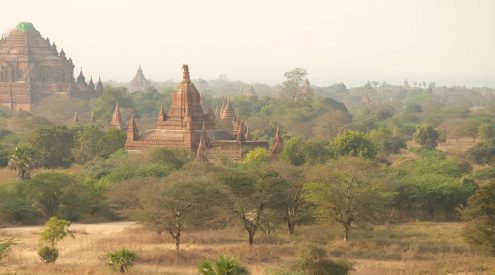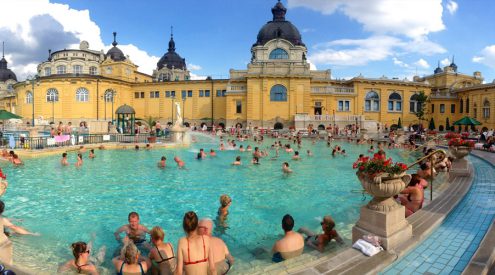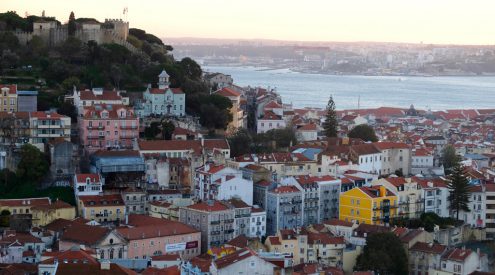The bedroom was icy. Fresh breaths of Arctic air sifted through unseen cracks, under the door, through the glass. My foot lay exposed. I snuck it back under the weight of blankets piled on top of me: three of them, thick and soft.
A steel cylinder stood in the corner of the room, stuffed with newspaper. A fire, waiting to be lit. It would have to wait. Behind the curtains lay another land: a land of eerie undulations, pointed stone chambers, and forgotten homes. Giant cones of volcanic tuff congregated in clusters, watching over this frozen village, Göreme.
Waking up amidst this landscape had the surreal quality of a dream, or a nightmare. The view from our window was alien. I felt elated, but disengaged from recognised reality. Our rented room was barren and old fashioned. It could have existed in any era, anywhere.
Bluish mountains lined the landscape out of our window. These alone were familiar. No modernisation or signs of life were evident. Sand dune shapes flowed into the distance, shrubbery growing atop them. Although they looked soft and sandy, these dunes were solid, composed of solidified volcanic ash, or tuff. Giant cones of the same brittle substance, some topped with basalt caps, protruded from the terrain, silent. After the eruptions of nearby Mt Erciyes and Mt Hasan about three million years ago, centuries of rain and erosion have weathered this soft volcanic landscape into the mysterious stone folds and outcrops that are Cappadocia.
From a distance, cut-out holes could be seen on the exterior of the towering cones. They were the windows and entrances to these hollowed out homes, carved from the stone as early as 4000 BCE (before the common era). A pervasive loneliness hung in the air, surrounding these abandoned homes. Deep in Anatolia, central Cappadocia is made up of about thirty tiny towns and villages, scattered with these stone dwellings, called “˜fairy chimneys’ by locals. It is an otherworldly scene.
Beyond the guesthouse where we had rented a room was Göreme – a village of 2000 people, most of whom were vying to make a living off tourism. In the centre, two roads run parallel, lined with restaurants, accommodation and curio shops. The cold weather had sent everyone indoors, so the familiar Turkish touting came from the thresholds of fire-lit shops and restaurants. ‘Where you from? Australia?’ young men would call, angling for a positive response to the safest guess they could make.
‘We see the tourists every year,’ Mustafa told us, once safely huddled beside the fire in his father’s restaurant. ‘We can see in their faces where they come from.’ Australia was the typical guess. And, because there can’t be many twenty-somethings left there, so widespread is their presence in “˜backpacker’ towns, it was a safe bet. Finland, Norway and Germany were some of the more adventurous speculations we encountered, presumably because of Iain’s height. Never South Africa though, not once.
Mustafa’s father’s restaurant became our daily retreat from the chill. It was the outstanding soup lunch that lured us back initially. Delicious minted lentil soup was served with crisp finger-burning bread, glossy with butter and over a foot long.
The décor was typically Turkish: rich coloured rugs, varnished beams of knotted wood, rustic clay ornaments and wooden string instruments fixed to the walls. A metal cylinder stood in the centre with a fire crackling inside. It was the same traditional structure as in our guesthouse room, with a metal pipe chimney that twisted its way through the room, warming the air around it, before exiting at the roof.
Göreme’s autumn was too cold for most tourists, so the restaurant was usually empty, which is how we got to know Mustafa. His career had been determined before he could even read, and since finishing school he had worked in this restaurant, which he now managed for his father. He was 25.
‘There are not so many South Africans here, but I met a girl here from South Africa,’ he told us one afternoon. His face was mischievous. ‘I only met this girl once,’ he continued, ‘I went with her to the hotel. But in the morning, when I put my trousers on “¦’ He paused, perhaps wondering how we would react to the story. So notorious was the tourist-Turk scenario that this was no surprise: he was a good looking young man. ‘My wallet was empty of all the money. There was maybe two hundred Lire there.’ He grinned a foolish grin.
‘No!’ I gasped, half laughing. Iain and I looked at each other in disbelief. But the real surprise was that South Africa’s crime had made it all the way to Turkey.
His family belonged to an ultra-nationalist movement, The Grey Wolves, named after a legendary wolf that led captive Turks to freedom. Established in 1969, the group’s ideal is to create the Turan (Great Turkish Empire), which includes all Turks, or Turkics, in the countries of the former Soviet Union, as well as China. The concept has been compared to the principles of the Aryan Empire proposed by the Nazi regime.
Mustafa wore a ring bearing The Grey Wolves’ crest, given to him by his father, but seemed more interested in moving to Eastern Europe to live with his girlfriend than in Turkish purity. There had been another item in the set, a bracelet, which he had given to the Eastern European, appalling his parents. The relationship itself went against every principle that his conservative Muslim family stood for.
A miniature bus, a dolmu?, took us to Uçhisar that afternoon. The citadel topped village was about half an hour away. A handful of locals got off the dolmu? with us and disappeared into the narrows of the village, to fire-lit homes. We wandered past stalls displaying Cappadocia ashtrays and ornaments, carved with the signature fairy chimney shapes which were echoed all around us. Sunset beckoned, and apart from the few stall owners, Uçhisar appeared desolate.
The citadel rises atop one of Uçhisar’s tuff pinnacles, in Cappadocia’s highest region. We disappeared inside the darkened cone, climbed towards its peak by rock carved stairs, and were spat out a few metres below the summit, where our ascent continued along the cone’s exterior. Beneath us, the fawn folds in the earth extended for miles; erosion at its most artistic. Burnt mustard was shaded into sandy crevices and grey-green foliage clung to undulating ridges, neatly stitched on. Giant rock mushrooms colonised from below.
Hidden escape tunnels, now eroded, are said to have run from inside the citadel to the depths of the valley floor. Imminent attack and the danger of erosion posed a threat to Cappadocia’s inhabitants for centuries. Under the Romans, many of Uçhisar’s stone cones were hollowed out and put to use as communal graves.
The next day, defrosting ourselves beside the fire, we whiled away our last afternoon with Mustafa, traditional Turkish music and a million glasses of çay. The same CD played on repeat at the restaurant every day, and the atmosphere it emanated left us craving more.
Poignant melodies drifted like smoke from an oboe, in melancholy minor key. A lone woman sung haunting tales of unknown woe, her words a mystery. Pregnant notes hung heavy in time, violins mourned, and Cappadocia was captured in a symphony of ambiguity, entrancing us. An accordion, a tambourine: rhythms hastened. Hands were clapping. I imagined jolly dancing. The wind blew silently outside, it stole a scarf in its gust. The music played on. I was happy.
Continue reading the Fairy Chimneys of Central Turkey at OldWorldWandering.com, travel stories written by a South African couple making their way from Shanghai to Cape Town overland.
















